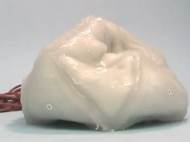iRobot’s shape-shifting blob robot takes its first “steps”
 The Defense Advanced Research Projects Agency and the U.S. Army Research Office awarded a multimillion-dollar contract to iRobot to create the flexible military robot. The maker of the Roomba and Scooba, along with University of Chicago researchers, develops the palm-size ChemBot as a mobile robot that can move over soft terrain and navigate through small openings, such as tiny wall cracks, during exploration and search-and-rescue missions.
The Defense Advanced Research Projects Agency and the U.S. Army Research Office awarded a multimillion-dollar contract to iRobot to create the flexible military robot. The maker of the Roomba and Scooba, along with University of Chicago researchers, develops the palm-size ChemBot as a mobile robot that can move over soft terrain and navigate through small openings, such as tiny wall cracks, during exploration and search-and-rescue missions.
It gets around by way of a process called “jamming”, in which material can transition between semi-liquid and solid states with only a slight change in volume. In ChemBot’s case, a flexible silicone skin encapsulates a series of pockets containing a mix of air and loosely packed particles. When air is removed from the compartments, the skin attempts to equalize the pressure differential by constricting the particles, which shift slightly to fill the void left by the evacuated air. In that way, the strange looking little blob inflates and deflates parts of its body, changing size and shape, oozes and pulsates across the floor. Beneath the skin are an incompressible fluid and an actuator that can vary its volume.
Still at an early stage of development potential applications for ChemBots include space exploration, military operations and medical devices that can be implanted in the human body. They might also prove useful for rescue operations in hostile environments such as subterranean or undersea mines and caves.
There are many issues which need to be solved, as powering unit which could ruin its ability to move through tiny openings or the applied materials which need to be changed in order to make it more durable and powerful. Could it lead to predecessors of T-1000 from the popular movie Terminator 2?
We wrote about this robot not because it is something revolutionary (similar robot concepts were around since 1980s), but as a public note on how military keeps on developing strangest technologies which can find their use for public long after those have been used as weapons. Let’s hope this robot finds its use for our better future.









First we had to worry about blob creatures enslaving humanity. Then we had to worry about robots enslaving humanity. Now we have to worry about blob robots (blobots) enslaving humanity.
Thanks a lot, scientists!
I think you’re right that in the short term we will be seeing more specialized robots, but there will come a point at which people are complaining that they have too many robots taking up physical space and why can’t all these tasks be consolidated into a single machine.